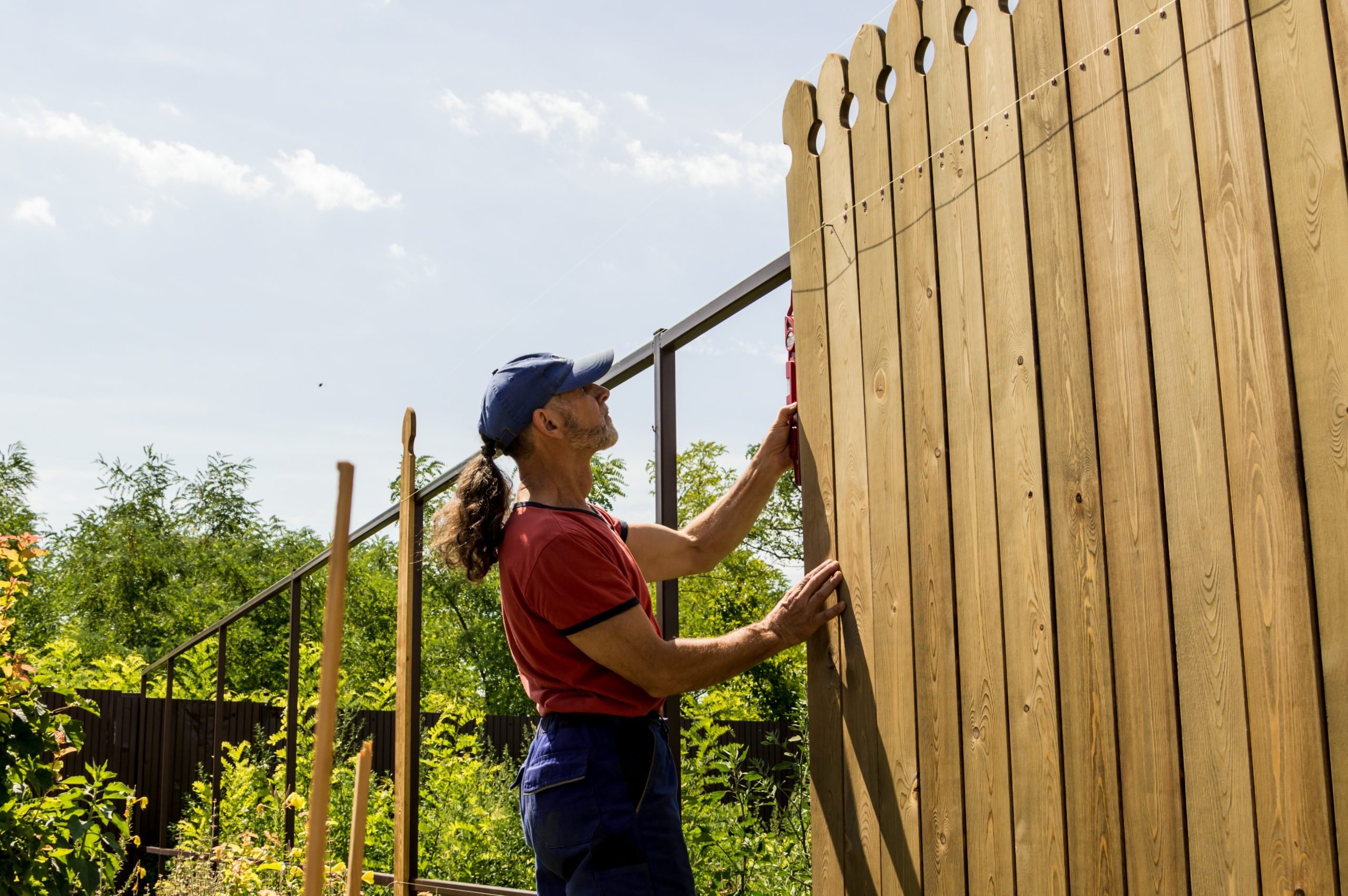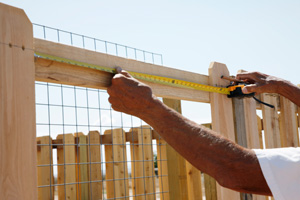How to Recognize Typical Problems That Require Immediate Fencing Repair Service
When it involves keeping your fencing, it is essential to detect concerns before they become larger issues. On a regular basis inspecting for indicators of deteriorating wood, leaning panels, or corrosion can conserve you time and money in the future. You could not realize just how climate and insects can jeopardize your fencing's honesty. Let's explore the usual indicators that show your fencing requires prompt attention, so you can maintain your building safe and secure and looking its finest.
Signs of Rotting Timber in Wooden Fences
Have you seen your wooden fencing looking a bit even worse for wear? If so, it may be time to look for signs of decomposing wood. Examine the base of the messages and panels for soft areas. If you continue the timber and it feels mushy or crumbles, that's a clear indicator of rot. Next off, look for staining or dark spots on the timber-- these often signal wetness damage. Pay attention to any peeling paint or coating, as this can expose the timber to further degeneration. In addition, a poignant, stuffy odor can suggest fungal growth. Do not fail to remember to check connections and joints; if they're loosened or breaking down, the timber below is most likely jeopardized. By catching these indicators early, you can prevent much more extensive damage and keep your fence standing strong. Routine upkeep is essential to expanding the life of your wood fencing.
Leaning or Tilting Fence Panels
It's important to understand what triggered it if you've noticed your fence panels leaning or tilting. This problem could indicate underlying structural damages that needs your interest. Allow's check out the common reasons and the repair options offered to obtain your fence back fit.

Sources Of Leaning Panels
When you see your fencing panels tilting or leaning, it's frequently an indicator of underlying concerns that need attending to. One common reason is insufficient drainage; excessive water can erode the dirt around the fencing posts, compromising their support. Another offender can be solid winds or storms that press against the panels, especially if they're not correctly secured. Additionally, the natural settling of dirt over time can cause posts to shift, bring about a tilt. Parasites, like termites, can jeopardize the integrity of wood panels, creating them to lean also. Ultimately, inadequate installation practices might result in panels not being firmly set, leaving them prone to leaning under stress. Address these issues quickly to keep your fencing's honesty.
Indications of Architectural Damages
Seeing tilting or leaning fence panels can be worrying, as these issues frequently indicate architectural damages that needs immediate attention. When your fencing begins to lean, it might signal that the messages are shifting or that the dirt around them has deteriorated. Pay attention to voids in between messages or panels, as these can additionally recommend instability. deck builder. Furthermore, check for splits or splintering in the wood, which can compromise the overall structure. It might jeopardize the integrity of the fencing if you observe corrosion or deterioration on metal elements. Remember, neglecting these indications can result in extra extreme damages down the line, so it's important to assess the circumstance quickly and take action before it gets worse
Repair Options Available

Rust and Corrosion in Metal Fences
If you possess a metal fence, you may see rust and rust sneaking in over time, specifically if it's exposed to dampness. These problems not just affect the look of your fencing however can likewise endanger its architectural integrity. To identify rust, try to find reddish-brown spots or spots, which indicate the steel is oxidizing. Rust can spread rapidly if left without treatment, leading and damaging the fence to pricey repairs.To deal with rust and deterioration, you need to clean the influenced areas with a wire brush and apply a rust-inhibiting primer. When the guide dries out, take into consideration painting the fencing with a weather-resistant paint to shield it better. Regular maintenance, such as evaluating for indications of rust and repairing paint as required, will assist prolong your fencing's lifespan. Addressing these concerns promptly guarantees your metal fence remains strong and aesthetically appealing for many years ahead.
Fractures and Splits in Plastic Fence

Reasons of Plastic Damage
Vinyl fencing is preferred for its durability, yet it can still struggle with splits and divides as a result of various elements. One significant reason is severe temperature changes. When plastic expands in the warmth and contracts in the cold, it can compromise the material gradually. Furthermore, direct exposure to severe sunlight can bring about UV deterioration, making the vinyl brittle. Physical effects, like hefty branches or accidental crashes, can additionally create cracks. Poor deck builder installation or using low-quality products can intensify these problems. Age plays a duty; older plastic fence is much more vulnerable to damages. Normal evaluations can assist you identify these aspects before they lead to considerable troubles. Take positive procedures to ensure your fencing continues to be undamaged and strong.
Repairing Cracks Properly
Splits and divides in your vinyl secure fencing can be worrying, addressing them quickly can prevent more damages and preserve the fencing's look. Evaluate the size of the crack. For little cracks, a plastic repair kit often includes adhesive that can bond the edges, providing a seamless repair. Clean the location thoroughly before using the sticky, ensuring it adheres effectively. For larger splits, you might need to utilize a vinyl spot. Cut the patch to size, use glue around the edges, and press it strongly onto the split. Permit it to treat based on the maker's guidelines. Normal maintenance and fast repair work can prolong your fencing's lifespan, maintaining it looking wonderful for many years to find.
Loosened or Missing Out On Fence Posts
Loosened or absent fencing articles can weaken the stability of your whole fence framework. It's necessary to deal with the concern right away if you discover any type of articles leaning or tottering. Look for any type of signs of movement, as this can cause further damages with time. You can conveniently analyze the trouble by giving each message a gentle shake-- if it really feels unsteady, it's time to take action.For missing out on posts, you'll require to replace them asap to preserve your fencing's honesty. Make sure they're safely secured in the ground with concrete or crushed rock for added stability when you mount brand-new messages. If a blog post hangs, tighten it by adding extra support or driving it deeper right into the ground.Ignoring these concerns can cause bigger issues, like spaces in your fencing and even full collapse. So, watch on your blog posts and remain proactive about fixings!
Damage From Climate and Natural Components
Weather condition and all-natural components can ruin your fencing, resulting in different types of damages that need prompt interest. Hefty rainfall can trigger timber to rot, making it weak and unpredictable. Snow accumulation might flex or break panels, while strong winds can root out fence messages or create areas to lean.If you see fractures or splintering in wooden fencings, it signifies drying as a result of extreme sunlight direct exposure. On the other hand, metal fencings can rust if protective coatings wear away, especially in seaside or humid areas.Inspect your fence frequently after tornados or severe weather to capture any damages early. Resolving these issues promptly can conserve you from pricey repairs down the line. Do not wait till a tiny issue develops into a major one; remain proactive and keep your fence top shape to preserve both functionality and visual appeal.
Parasite Invasion and Termite Damage
It's crucial to act quickly to stop more destruction when you discover signs of bug problem or termite damage. Try to find mud tubes along your fence or hollow-sounding wood, as these show termites are at job. You may likewise see small holes or frass, which is termite droppings appearing like sawdust. If you spot any of these indications, it's time to evaluate the damage.Don' t wait till it's far too late; parasites can jeopardize your fence's stability. Check the surrounding location for beetles or ants, as they might be adding to the issue. If you suspect a problem, think about speaking to an insect control professional to deal with the issue.repairing and confirm or replacing afflicted areas of your fencing quickly not only recovers its stamina yet also avoids insects from spreading out better. Keep cautious to maintain your building pest-free and safe and secure.
Often Asked Inquiries
Just how Usually Should I Evaluate My Fence for Damages?
You must evaluate your fence at the very least twice a year, preferably during spring and fall. Regular checks aid you spot damages early, saving you money and time on fixings while maintaining your residential or commercial property's appearance and security.
Can I Repair a Fencing Myself or Work With a Specialist?
If you have the right tools and abilities, you can most definitely repair a fence on your own. Hiring a professional warranties top quality work and conserves you time, particularly for complex repair work or comprehensive damage.
What Devices Are Required for Basic Fence Repairs?
For basic fencing repairs, you'll require devices like a hammer, screwdriver, pliers, a saw, a degree, and measuring tape. deck builder. Depending on the repair, you might also need nails, screws, or substitute boards
Just How Much Does Fencing Fixing Usually Price?
Fence repair work costs vary commonly, however you can expect to pay in between $200 and $1,500 depending upon products, labor, and level of damage. It's smart to get multiple quotes for the finest deal.
When Is the most effective Time of Year for Fence Repairs?
The most effective time for fencing repair work is during mild weather condition, typically in springtime or very early loss. You'll prevent severe temperatures, making it much easier to work and ensuring the materials established appropriately for lasting sturdiness (deck builder). Discovering turning or leaning fence panels can be alarming, as these problems commonly indicate architectural damage that requires instant focus. Missing or loosened fencing blog posts can undermine the security of your entire fence structure. Snow accumulation might flex or damage panels, while strong winds can uproot fencing blog posts or create areas to lean.If you discover fractures or splintering in wood fencings, it's a sign of drying out due to extreme sun direct exposure. Steel fences can rust if protective layers put on off, particularly in coastal or moist areas.Inspect your fence regularly after tornados or extreme climate to capture any kind of damage early. Fencing fixing expenses vary widely, yet you can expect to pay in between $200 and $1,500 depending on materials, labor, and degree of damages